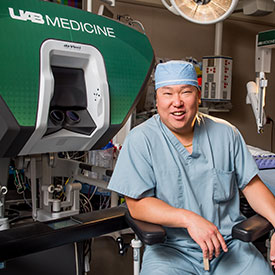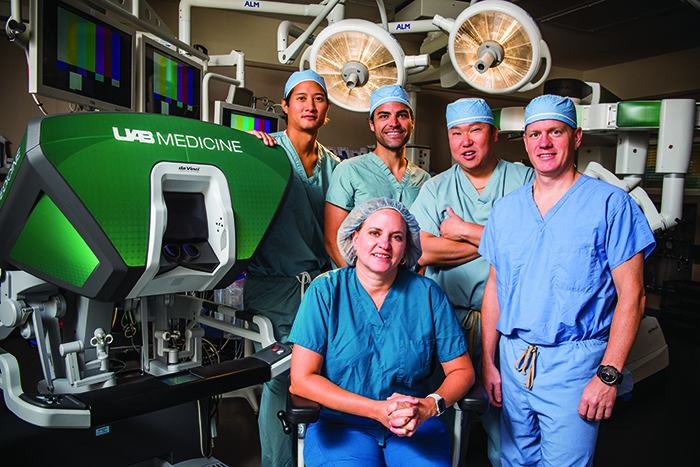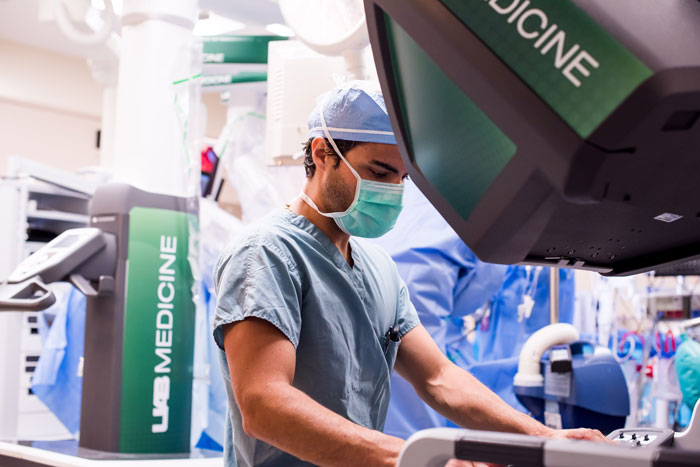 Led by Kenneth Kim, UAB is developing a new model of precision and rigor in robotic surgery training. Robotic surgery may be on the leading edge of surgical techniques, but it is the time-tested approach of spending time with and listening to residents that is helping make UAB’s robotic surgery training program one of the most advanced and rigorous in the country.
Led by Kenneth Kim, UAB is developing a new model of precision and rigor in robotic surgery training. Robotic surgery may be on the leading edge of surgical techniques, but it is the time-tested approach of spending time with and listening to residents that is helping make UAB’s robotic surgery training program one of the most advanced and rigorous in the country.
“I am a little bit crazy,” admits Kenneth Kim, M.D., associate professor in the Department of Obstetrics and Gynecology. “No normal surgeon sits with every resident—and I have 32 of them—for an hour each, every three months to train on the robot. That’s 32 hours for motion and simulation, one-on-one.”
Kim, who pursued a Master in Health Professions Education degree following his medical degree, made it his mission to revamp the training program for robotic surgery at UAB. Thanks to his efforts, UAB’s is the nation’s only hands-on robotic surgery training program that starts at the outset of medical school; is highly rigorous in both its measurement protocols and the amount of time logged on the robots; and is cross-disciplinary, spanning multiple surgical fields.
“The best educators and teachers are the ones who can adapt their teaching style to the learner,” Kim says. “I specifically study how people best learn surgical techniques and procedures. From the outset the process is coded in the motor cortex section of the brain and then eventually gets coded in the cerebellum—like when you learn to brush your teeth or walk. It becomes automatic over time and with practice.”
Along with fellow surgeons across various fields, he has created a robotic surgery training program that is unique in its quantitative measurement protocols and tracking of residents’ progress as they train.
Kim’s passion for robotic surgery, his experience as an educator, and his collaborative nature have combined to create a unique training program that reflects the excellence of UAB’s robotic surgery programs, which is on track to achieve a major milestone. This spring, UAB will surpass the 10,000 robotic surgeries mark, a feat that helps make UAB the leader in robotic surgery volume in the country.
Robots in the OR
There are three types of surgery: open, the traditional form; laparoscopic, using a laparoscope to view inside the body from a small incision; and robotic surgery, which is a form of minimally invasive surgery and provides surgeons with precision movement and 3-D camera views of the patient.
“Robotic surgery is certainly more advantageous for specific procedures,” says Drew Gunnells, M.D., administrative chief resident in the Department of Surgery. “You have more dexterity and your visualization is often better.”
Jamie Cannon, M.D, associate professor in the Department of Surgery, is one of the highest volume colorectal robotic surgeons in the country. “The tools the robot gives you make it easier to conduct an operation, so you can do more complex, difficult surgeries,” she says. “I can help more patients using a minimally invasive approach than with laparoscopic or open.”
The training program Kim and his colleagues designed uses simulation to measure hand motion and manipulation of the camera. UAB is the only hospital to employ a measurement system to track residents as they learn to use these tools.
“We are five years ahead of the rest of the world in training robotic surgery to residents,” says John Porterfield, M.D., associate professor in the Department of Surgery and director of the General Surgery Residency Program. Porterfield also advocates educating medical students about robotic surgery as early as possible in medical school.
 Clockwise from left: Benjamin Wei, Jeffrey Nix, Kenneth Kim, John Porterfield, and Jamie Cannon are some of the faculty members who have contributed their time and expertise to making UAB’s one of the most advanced robotic surgery training programs in the country.
Clockwise from left: Benjamin Wei, Jeffrey Nix, Kenneth Kim, John Porterfield, and Jamie Cannon are some of the faculty members who have contributed their time and expertise to making UAB’s one of the most advanced robotic surgery training programs in the country.
“Early in medical school, people are more teachable,” he says. “We moved this training from the fifth year to the first, starting with bedside training, then a virtual simulator.”
“Learning surgery is a lot like learning a sport,” Kim elaborates. “We’d never have an athlete learn a sport while they’re playing the game. We revamped our training program to make it more high-yield for the residents.”
This includes the acquisition and use of teaching consoles with each robotic surgical system, allowing for simulation and practice outside of the operating room, with the oversight of a surgeon while residents practice. “This is incredibly rare,” says Andrew Papoy, M.D., administrative chief resident in the Department of Surgery. “Without the teaching consoles, it’s like watching the procedure on TV, rather than doing it myself. Dr. Porterfield can stop what I’m doing in a surgery and move my hands, for example.”
There is a set score that trainees must achieve on the simulator before they can sit next to a surgeon with a patient. “They hate to watch, because watching surgery for a surgeon is just terrible,” Porterfield says. “We’re training them by putting them in a live environment, then guiding them through that environment very closely. Then we’re looking at it from a bit of a distance standing at a monitor, and finally they operate independently.”
According to Porterfield, of the 254 general surgery programs in the U.S., about a dozen allow their surgeons to train enough in robotic surgery that they can perform a surgery upon completion. The result, UAB surgery residents say, is they are noticeably advanced among their peers.
“It has helped tremendously in my comfort and ability with the robot,” says Danny Mounir, M.D., an administrative chief resident in the Department of Obstetrics and Gynecology. “I feel very comfortable now and confident in my future goals.”
“I knew UAB was one of the best programs in the nation for robotic surgery, but I didn’t realize how good it is until I talked to my peers enrolled in other programs nationwide,” says Teresa Boitano, M.D., a PGY-2 resident in the Department of Obstetrics and Gynecology.
Quantifying Progress
 UAB's one-of-a-kind simulator was designed in collaboration with Intuitive Surgical, a manufacturer of robotic surgery systems.UAB has a one-of-a-kind simulator designed in collaboration with Intuitive Surgical—a manufacturer of robotic surgery systems—that has programs for all of the procedures currently existing in robotic surgery, including hernia repair, lung lobectomy, prostatectomy, and hysterectomy, among others. UAB surgical residents—who specialize in everything from gynecology to general surgery to urology—are training on these tools to test them, which will also assist in collaborating with the company to design the next generation of teaching tools and simulations.
UAB's one-of-a-kind simulator was designed in collaboration with Intuitive Surgical, a manufacturer of robotic surgery systems.UAB has a one-of-a-kind simulator designed in collaboration with Intuitive Surgical—a manufacturer of robotic surgery systems—that has programs for all of the procedures currently existing in robotic surgery, including hernia repair, lung lobectomy, prostatectomy, and hysterectomy, among others. UAB surgical residents—who specialize in everything from gynecology to general surgery to urology—are training on these tools to test them, which will also assist in collaborating with the company to design the next generation of teaching tools and simulations.
The extensive training also allows for the simultaneous collection of data, which can then be used to quantify performance on the simulator. Jeffrey Nix, M.D., assistant professor in the Department of Urology and director of Robotic Surgery, specializes in the use of robotic surgery to treat cancers. He is working with Kim and colleagues across campus to expand and improve the robotic surgery curriculum, focusing on data collection.
“Any time a resident gets on the simulator and touches the console, everything they do is plotted on an X-Y-Z graph,” Nix says. “We’ll have objective data on how many clicks it took them, what their path was, if they ran into the floor or ceiling, and how far in they zoomed, among other measurements.”
Nix hopes these data will allow for the development of a credentialing process for robotic surgery. “From open surgery you can’t collect these data; they are very subjective,” he says. “Here you can show what an expert surgeon looks like on a simulator, and compare novice and experienced surgeons. Our hypothesis is that you can then move trainees from novice to experienced surgeons more quickly.”
Patient Benefits
Residents are not the only beneficiaries of advanced training in robotic surgery. Because robotic surgery is a form of minimally invasive surgery, patients stand to gain from decreased post-operative hospitalization time and pain at the site of the incision.
“It’s amazing how much the post-operative course is accelerated and improved with this,” Mounir says. “Patients usually respond with joy when hearing their discharge may be the same day, versus the next day.”
Additionally, radiation and other treatments for certain cancers may start sooner after surgery in some cases. “We can do the surgical procedure through a tiny little hole, and if chemotherapy is required, the patient can start it quicker because they recover faster,” Boitano says.
Nix sees personalized medicine and improved patient outcomes—with reduced health care costs—as the vanguard of robotic surgery. “This isn’t where minimally invasive surgery will stop,” he says. “We want it to continue to become less invasive. As the technology develops, we see patient-specific simulation coming online.”
“Right now we’re helping develop the next generation of training tools and simulations, but we also have to adapt with the technology as it evolves,” Kim says.
UAB remains on the forefront with this training, says Porterfield, who travels nationally—either joining forces with Kim or going on his own—to teach others about UAB’s training program. Kim notes this approach helps them cover as much ground as possible. It also speaks to their collaborative nature, which is rare among surgeons in different disciplines.
“In the past five years more than 750 surgeons in all specialties have visited UAB to learn this program,” Porterfield says. “Very few places are willing to do what we’re doing, and even fewer are giving it away. It keeps UAB as a leader.”
As he talks, he pauses to receive an incoming text from Kim, thanking him for assistance on a combination surgery performed together earlier that morning. “This is what it’s all about,” Porterfield says.
“The collaborative spirit here is palpable,” Nix agrees. “We just know this is the right thing to do.”
By Christina CrowePhotos by Nik Layman